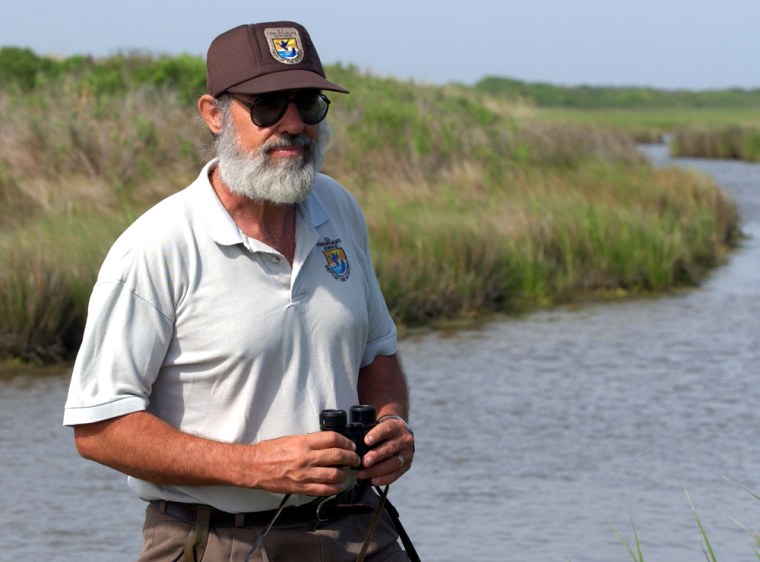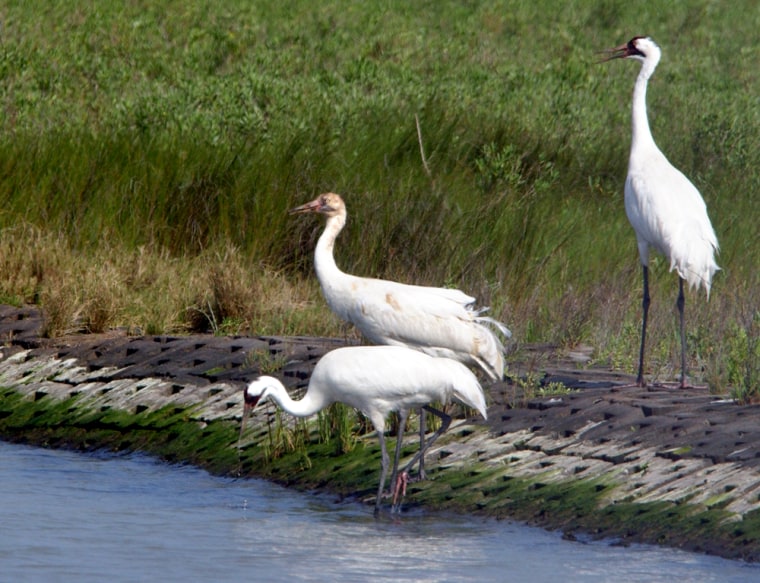Armed with a pencil and a clipboard full of detailed color aerial maps, wildlife biologist Tom Stehn climbs into a tiny Cessna aircraft to document the well-being of one of the rarest birds in North America.
For about seven hours, usually on Wednesdays, Stehn flies 200 feet above a 35-mile-long section of Texas coastline near Corpus Christi to check marshes, barrier reefs and islands for what blossomed this year to a record flock of 217 wild whooping cranes.
“I try to find every crane,” said Stehn, who crisscrosses the territory in quarter-mile segments. “On a sunny day, I can see them a mile away.”
Stehn became a crane expert by necessity when he transferred in 1982 to the Aransas National Wildlife Refuge, the winter home to the only remaining known wild whooping cranes on the continent. The Schenectady, N.Y., native is now the U.S. Fish and Wildlife Service’s Whooping Crane Coordinator.
Although the birds average about 15 pounds in weight, the typical whooping crane stands nearly 5 feet tall, making it the continent’s tallest bird. It has black facial markings and a bare patch of red skin at the top of its head. Its white feathers contrast sharply with the lush green grasses and muddy brown waters of the Texas coast.
“You see the horizon, the cranes in the marsh, the oak trees in the distance. That’s the way it’s looked for hundreds and hundreds of years,” Stehn said after a recent flight. “These birds have come generation after generation, dating back hundreds of thousands of years. It’s part of a natural system and we want to keep it that way if at all possible.”
Development pressure
While spotting the elusive whooping crane — whose shriek provides its name — is not particularly difficult, saving the endangered species remains a challenge as waterfront development continues at the refuge’s edges, Texas’ population grows and the demand for fresh water increases, Stehn said.

Even though the bird’s overall numbers are meager, they do represent a remarkable comeback. In 1941, only 15 whooping cranes were known to exist in the wild. They survived the uncontrolled hunting at the time and development of drained wetlands, which eliminated the birds’ natural habitat stretching from Mexico to northern Canada.
Now, “they’re all right here,” Stehn said.
But not for long.
With extended hours of daylight signaling the onset of spring and summer, the wild cranes instinctively head north for a hazardous 2,500-mile flight to Wood Buffalo National Park in Canada’s Northwest Territories, where most of them make their summer home. A few started leaving Texas in early April. By early May, they’ll all be gone.
It wasn’t until 1954, when a Canadian fire crew accidentally discovered them, that anyone even knew where the birds went when they made their annual migration from Texas.
Canadian stay a mystery
How many reach Canada this spring — avoiding such threats as power lines, cell phone towers, wind farms, bobcats and coyotes, and hunters who illegally and perhaps ignorantly shoot at them — won’t be known. The remoteness of the Canadian park, the tall spruce trees that can hide the birds and a nesting area that spans more 1,000 miles makes an accurate count impossible.
That means not until October, when the cranes return to Texas, perhaps with some newborn chicks, will Stehn know if the flock is continuing its slow recovery from near extinction.
The birds, which have a life span of about 25 years, mate for life. A female generally will hatch two eggs in the summer but only one survives. The chick accompanies its parents back to Texas. But unlike most birds, whooping cranes have no genetic code that tells them to migrate to a certain spot.
“Then for the rest of its life, the chick will make the migration back and forth from the nesting grounds and then back here,” Stehn said. “And when it mates, it will try to establish a territory right next to mom and pop.”
This year’s Texas flock, which lost two birds over the winter to natural causes, is up from 194 a year ago, which topped the previous high of 188 counted in Texas in the winter of 2000, he said.
Hurricane help
A number of factors have influenced the gains, among them good rains that helped balance the salt content of the marshes and provide growth for blue crabs, the crane’s favorite food. Hurricane Claudette in 2003 helped reopen a natural pass between the coastal bays and the Gulf of Mexico, also aiding blue crab proliferation.
Refuge managers also use controlled burns to eliminate tall grass, making it easier for the birds to seek acorns on trees without the worry of lurking predators. And refuge managers have constructed ponds to provide alternate fresh water sources for the birds when the marshes get too salty.
The whooping cranes are a good tourism draw, too, with thousands of people from around the world visiting the refuge each year. Many board tour boats that take them close to the rare bird.
What they see is an elegant flyer, wings flapping slowly, neck extended forward and legs trailing. When its wings extend some 7 feet, the crane reveals its distinctive black wingtips. In flight, it’s more akin to the stylishness of a Concorde jet compare with birds that dart through the sky like a fighter jet.
“It’s a magical place,” Barbara Haskins, 62, of Cloona, Ireland, said after seeing the birds during an outing aboard the Skimmer, a boat operated by Rockport Birding and Kayak Adventures. She was joined by her husband, Harry, 68, a retired transportation manager for Dublin-based Guinness Brewery.
“It was well worth the trip,” said Bob Wargel, 64, from Winnetka, Ill., who with his wife, Judy, 61, was part of a group on a birding tour of Texas. “Having the whoopers here made it even better.”
